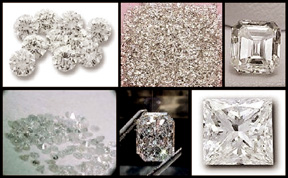
Diamonds: The sparkling mineral
Diamonds are popularly known as a girl's best friend. It is also
known as a measure of the wealth of a person. The name diamond is
derived from the ancient Greek word adamas which means 'invincible'.
They have been treasured as gemstones, since their use as religious
icons in India, at least 2500 years ago, and usage in drill bits and
engraving tools which also date to early human history.

The earliest written reference to diamonds can be found in the
Buddhist text, the Anguttara Nikaya and another Sanskrit text, the
Arthashastra, which was completed around 296 BC, which describes the
diamond's hardness, lustre, and dispersion.
In Western culture, diamonds are the traditional emblem of
fearlessness and virtue, but have also been associated with power,
wealth, crime and misfortune.
Today, diamonds are used to symbolise eternity and love, often being
seen adorning engagement rings and sometimes wedding rings as well.
It is the most popular and most useful, of more than 3,000 known
minerals. Besides graphite, it is the only gem known to man that is made
of a single element, carbon.
Diamonds can be used to polish, cut or wear away any material,
including even other diamonds. Common industrial adaptations of this
ability include diamond-tipped drill bits and saws, or the use of
diamond powder as abrasive. It is also used as semiconductors: some
valuable diamonds are natural semiconductors, in contrast to most other
diamonds, which are excellent electrical insulators.

They make excellent abrasive, because they can be scratched only by
other diamonds, ultra hard fullerite, or aggregated diamond nanorods,
which also mean they hold a polish extremely well. So, diamonds are
highly recommended for daily use.
Now, let's check out the geological aspects of this precious stone
that originates from carbon... Diamonds can form in most of Earth's
interior, but not very close to the surface. They form in high pressure
and high temperature. Graphite is the most stable form of carbon on the
Earth's surface, but diamonds found deep inside the Earth survive,
because it requires high temperature to melt the diamond structure.
Diamonds reach the Earth's surface with the help of magma. This magma
rises and erupts in small, but violent volcanoes. Just beneath such
volcanoes is a carrot shaped 'pipe' filled with volcanic rock, mantle
fragments and some embedded diamonds.
The rock is called kimberlite after the city of Kimberley, South
Africa, where the pipes were first discovered in the 1870's. Another
rock that provides diamonds is lamproite.
How carbon forms
The carbon that makes diamonds, come from the melting of pre-existing
rocks in the Earth's upper mantle. There is an abundance of carbon atoms
in the mantle. Temperature changes in the upper mantle force the carbon
atoms to go deeper where it melts, and finally becomes new rock, when
the temperature reduces.
If other conditions like the pressure and chemistry are right, then,
the carbon atoms in the melting crystal rock bond to build diamond
crystals. However, there is no guarantee that these carbon atoms will
turn into diamonds. If the temperature rises or the pressure drops,
then, the diamond crystals may melt partially, or dissolve totally. Even
if diamond crystals do form, it would take thousands of years for those
diamonds to come anywhere near the surface, for people to mine.
Diamond deposits are called Kimberlite Pipes or Blue Ground. These
are also called primarymines. Diamonds can also be found in river beds.
When you own a piece of diamond, you own something which is a legend
in the making. It has not been made in a factory just the other day. A
diamond comes from the deep end of the Earth, and not all diamonds are
taken to adorn jewellery, as we mentioned above, they are used for other
work as well.
Only one fourth the quantity of diamonds that are mined is made into
jewellery.
Every 100 tons of mud produces one carat of diamond, and this one
carat is not one stone! It could be anything from 0.005 carat to one
carat. See how valuable and amazing a diamond is! It is a precious stone
we get from carbonised material from deep within the bowels of the
Earth. Mother Nature is hard at work to bring these precious diamond
crystals to us, and man is that much richer because of such precious
gifts that she gives us. Yet, we are not grateful to Mother nature.
Find out more about the long and interesting process by which these
sparkling gems are born from a mineral and how they end up as the most
valued stones on Earth!
Janani |


